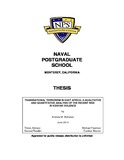Strategies for countering terrorist safe havens
| dc.contributor.advisor | Gregg, Heather | |
| dc.contributor.author | Nielsen, Kenneth E. | |
| dc.contributor.author | Thomson, Robert L. | |
| dc.date | Dec-13 | |
| dc.date.accessioned | 2014-02-18T23:39:10Z | |
| dc.date.available | 2014-02-18T23:39:10Z | |
| dc.date.issued | 2013-12 | |
| dc.identifier.uri | https://hdl.handle.net/10945/38988 | |
| dc.description | Replaced new revision 02/24/2014 | en_US |
| dc.description.abstract | More than a decade after the attacks on 9/11, United States leadership continues to place a high priority on pursuing terrorists and denying them safe havens from which they can recruit, train, and plan operations. In a time of decreasing budgets and growing sentiment avidly against involvement in prolonged wars, the U.S. must adapt strategies to meet the future threats posed by terrorist safe havens. This thesis offers strategies for countering safe havens. It begins by arguing that safe havens are not just geographic areas, but that they also include a demographic component that allows terrorists a population among which to hide. The thesis then presents four strategies aimed at denying geographic and demographic safe havens: leadership targeting within safe havens, tactical containment, pseudo operations, and surrogate security forces. The thesis draws from four historical case studies to examine these strategies, including the Peruvian governments efforts to combat the Shining Path, French containment of the Casbah in Algerias war of independence, Rhodesias Selous Scouts experience with pseudo operations, and U.S. co-option of the Sons of Iraq in Anbar Province. The thesis finds that no single strategy is sufficient for dealing with geographic and demographic safe havens. Rather, a combination of strategies, properly sequenced, can reduce terrorist safe havens. Furthermore, none of these strategies works without counterinsurgency forces positively engaging the population, setting the necessary conditions for separating insurgents from their demographic and geographic supports. | en_US |
| dc.description.uri | http://archive.org/details/strategiesforcou1094538988 | |
| dc.publisher | Monterey, California: Naval Postgraduate School | en_US |
| dc.rights | This publication is a work of the U.S. Government as defined in Title 17, United States Code, Section 101. Copyright protection is not available for this work in the United States. | en_US |
| dc.title | Strategies for countering terrorist safe havens | en_US |
| dc.type | Thesis | en_US |
| dc.contributor.secondreader | Lober, George | |
| dc.contributor.department | Defense Analysis (DA) | |
| dc.subject.author | Safe havens | en_US |
| dc.subject.author | counterinsurgency | en_US |
| dc.subject.author | demographics | en_US |
| dc.subject.author | Shining Path | en_US |
| dc.subject.author | Sendero Luminoso | en_US |
| dc.subject.author | Peru | en_US |
| dc.subject.author | Algiers | en_US |
| dc.subject.author | FLN | en_US |
| dc.subject.author | Rhodesia | en_US |
| dc.subject.author | Selous Scouts | en_US |
| dc.subject.author | Anbar | en_US |
| dc.subject.author | Sons of Iraq | en_US |
| dc.subject.author | SOI | en_US |
| dc.subject.author | leadership targeting | en_US |
| dc.subject.author | decapitation | en_US |
| dc.subject.author | containment | en_US |
| dc.subject.author | pseudo operations | en_US |
| dc.subject.author | co-opting | en_US |
| dc.subject.author | surrogate security forces | en_US |
| dc.subject.author | insurgency. | en_US |
| dc.description.service | Major, Army | en_US |
| etd.thesisdegree.name | Master Of Science In Defense Analysis | en_US |
| etd.thesisdegree.level | Masters | en_US |
| etd.thesisdegree.discipline | Defense Analysis | en_US |
| etd.thesisdegree.grantor | Naval Postgraduate School | en_US |
| dc.description.distributionstatement | Approved for public release; distribution is unlimited. |
Files in this item
This item appears in the following Collection(s)
-
1. Thesis and Dissertation Collection, all items
Publicly releasable NPS Theses, Dissertations, MBA Professional Reports, Joint Applied Projects, Systems Engineering Project Reports and other NPS degree-earning written works.





